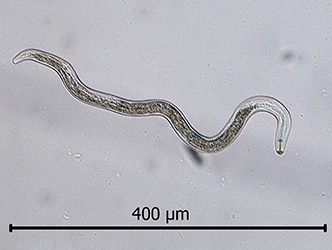Nematodes
General Description
Nematodes are translucent, microscopic roundworms, typically measuring 0.25 to 1 mm in length and only about 0.1 to 0.2 mm in diameter. Most nematodes in soil are beneficial components of the soil ecosystem, where they feed on bacteria, fungi and other micro-invertebrates, stimulating and regulating the turnover of nutrients. Their abundance ranges from about 1000 per liter of degraded or infertile soil, up to 50,000 per liter of highly fertile soil. Some nematode species, however, parasitize plant roots and are economically important plant pathogens.
 |
| Root lesion nematode |
Symptoms:
Nematode damage is often overlooked because the above-ground symptoms are non-specific and difficult to distinguish from effects of other factors. Nematode populations usually exist in patches of high population densities. Thus typical symptoms include poor tree vigour in patches of one to dozens of trees. This patchy, uneven growth caused by plant-parasitic nematodes may occur within an orchard with uniform soil conditions. Areas with high nematode population densities may also be correlated with other soil factors that can affect tree vigour. For example, many species of plant-parasitic nematodes reach higher populations and cause more damage in sandy soils than in finer-textured soils. As a result, poor crop growth in sandy soils can be the result of low water or nutrient availability as well as the interaction of these additional stresses with nematode damage.
Nematode species:
The main plant-parasitic nematode species of significance to tree-fruit production are the root-lesion nematodes (Pratylenchus penetrans), dagger nematodes (Xiphinema species), and ring nematodes (Mesocriconema xenoplax):
Root-lesion nematodes: These nematodes are migratory endoparasites, burrowing into roots to feed, and migrating freely between root tissue and soil. Root-lesion nematodes cause symptoms that range from many small lesions on young feeder roots to abnormal darkening and necrosis or death of the roots. Severely damaged root systems will have few newly formed feeder roots and sparse tufts of fine roots that will be blackened and crumbly. In a replant situation, preplant population densities greater than 50 nematodes per 100 ml soil will cause significant reduction in growth of replant trees. The relationship between root-lesion nematode population densities and vigour of older, established trees is not well understood, and threshold populations for treatment have not been established.
Dagger nematodes: These nematodes are ectoparasites; they do not burrow into roots, but insert their long stylets (syringe-like mouthparts) deep into root tips, where they feed on root tip cells. Dagger nematode feeding causes some necrosis and stunting and swelling of root tips, but they seldom cause significant damage on their own. Dagger nematodes are mostly important as vectors of tomato ringspot and cherry raspleaf viruses. If one of these viruses becomes a problem in an orchard, then the soil should be tested for dagger nematodes and fumigated to eliminate them before replanting.
Ring nematodes: These nematodes are ectoparasites that use long stylets to extract the contents of root cells, especially at root tips. They cause necrosis or blackening of roots like root-lesion nematodes, but their preferential feeding at root tips also causes stunting and sometimes formation of swollen or malformed root tips without obvious necrosis. Preferred hosts for ring nematodes include cherry, peach, apricot, plum and grape. These nematodes are well known to cause significant damage to stone fruit crops in other growing regions. While ring nematodes have recently been found to be relatively widespread in the Okanagan Valley, their impacts on tree fruit production in B.C. are not well understood at this time.
Nematode sampling and testing:
Sampling strategies and interpretation of the results depend on the nematode species suspected and environmental conditions, and should be developed in consultation with a diagnostic laboratory. Populations of all nematode species vary seasonally. Since some nematode species migrate between roots and soil, it is usually necessary to collect both soil and root samples for testing. The laboratory analysis includes extraction of nematodes from soil and plant tissue, identification of the species present, and enumeration. The absence of recognized nematode pathogens in diagnostic samples can be used to rule-out nematodes as the cause of poor crop growth.
Soil analysis for the presence of nematodes is provided by the following laboratories. Contact the labs directly for information on fees and sampling instructions:
BC Tree Fruits Quality Development Laboratory,
9571 Bottom Wood Lake Road,
Lake Country,BC, V4V 1S7,
Phone: 250-766-2527 ext 205
M.B. Laboratories Ltd
10115C McDonald Park Road,
Sidney, B.C. V8L 5X5
Web: www.mblabs.com
Phone 250-656-1334
British Columbia Ministry of Agriculture,
Plant Health Laboratory,
Abbotsford Agriculture Centre,
1767 Angus Campbell Road,
Abbotsford, B.C. V3G 2M3
Phone: 604-556-3003
Phone: 1-800-661-9903 (toll free)
Management
Chemical Control
Nematodes are best managed before planting. Prevention involves testing for the presence of pathogenic nematodes followed by pre-plant soil fumigation to reduce nematode populations. See notes under Replant Disease for more information on soil fumigation. There are no chemical treatments for nematodes that can be used on bearing fruit trees in Canada.
The insecticide Vydate (oxamyl) will provide some control of nematodes but it can only be used on non-bearing apple trees. Caution - Vydate is a highly toxic, restricted product (applicator certification is mandatory).
Velum Prime (fluopyram) has been approved for use on Pome and Stone fruits for nematodes. Apply specified dosage by chemigation into root-zone through low-pressure drip, trickle, micro-sprinkler or equivalent equipment. Soil must be slightly pre-wetted to break soil surface tension prior to application. Caution - Velum Prime requires a vegatative strip when used near aquatic area. It is toxic to aquatic organisms, non-target terrestrial plants and birds. Avoid application when heavy rainfall is forecast. To prevent contamination of aquatic habitats, avoid application to areas with moderate to steep slopes, compacted soil or clay.
Salibro Nematicide (fluazaindolizine) has been approved for use on non-bearing stone fruit to control or suppress root-knot nematodes. It can be applied pre plant incorporated, broadcast followed by soil incorporation, in furrow, or via chemigation.
Updated January, 2024
